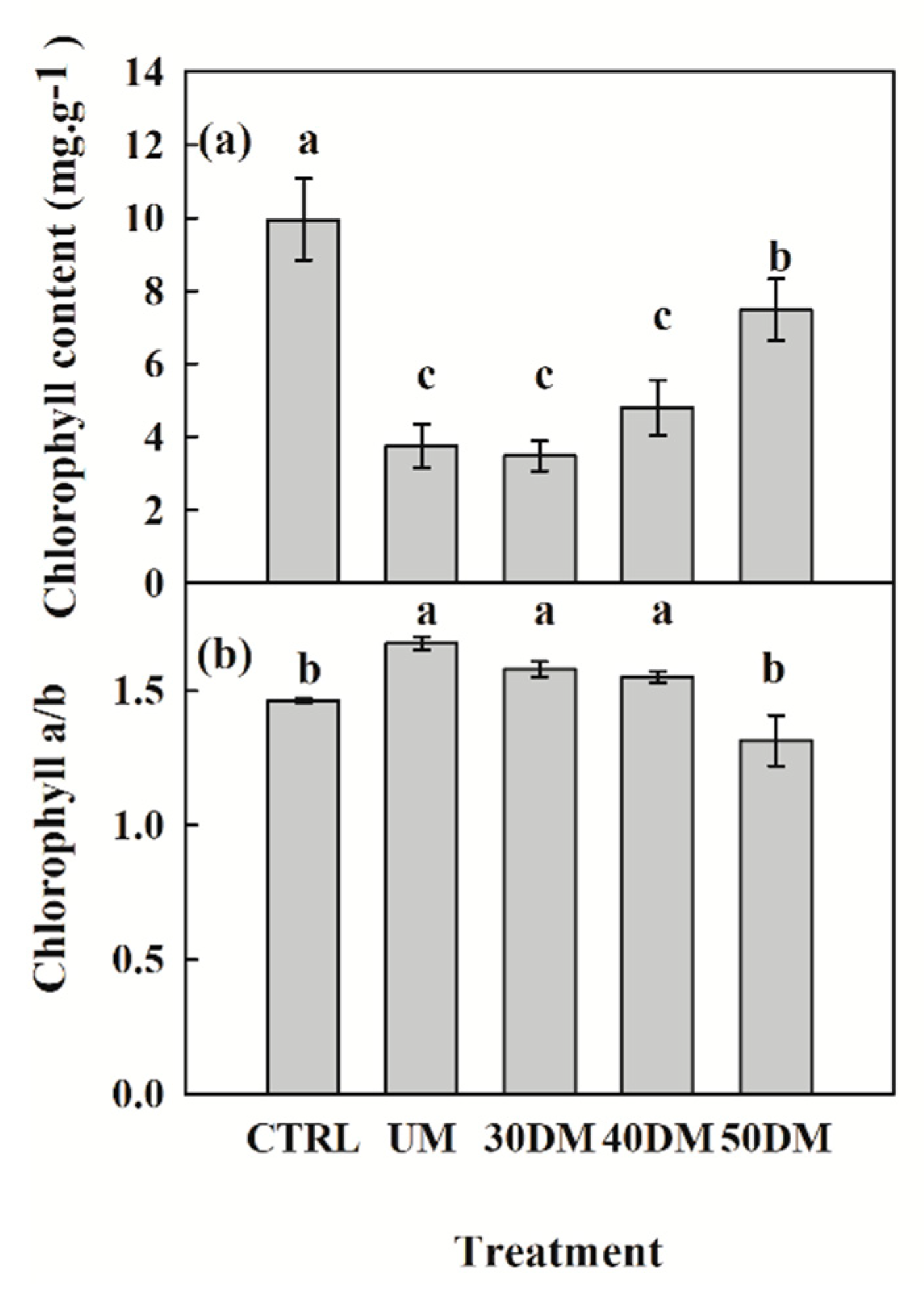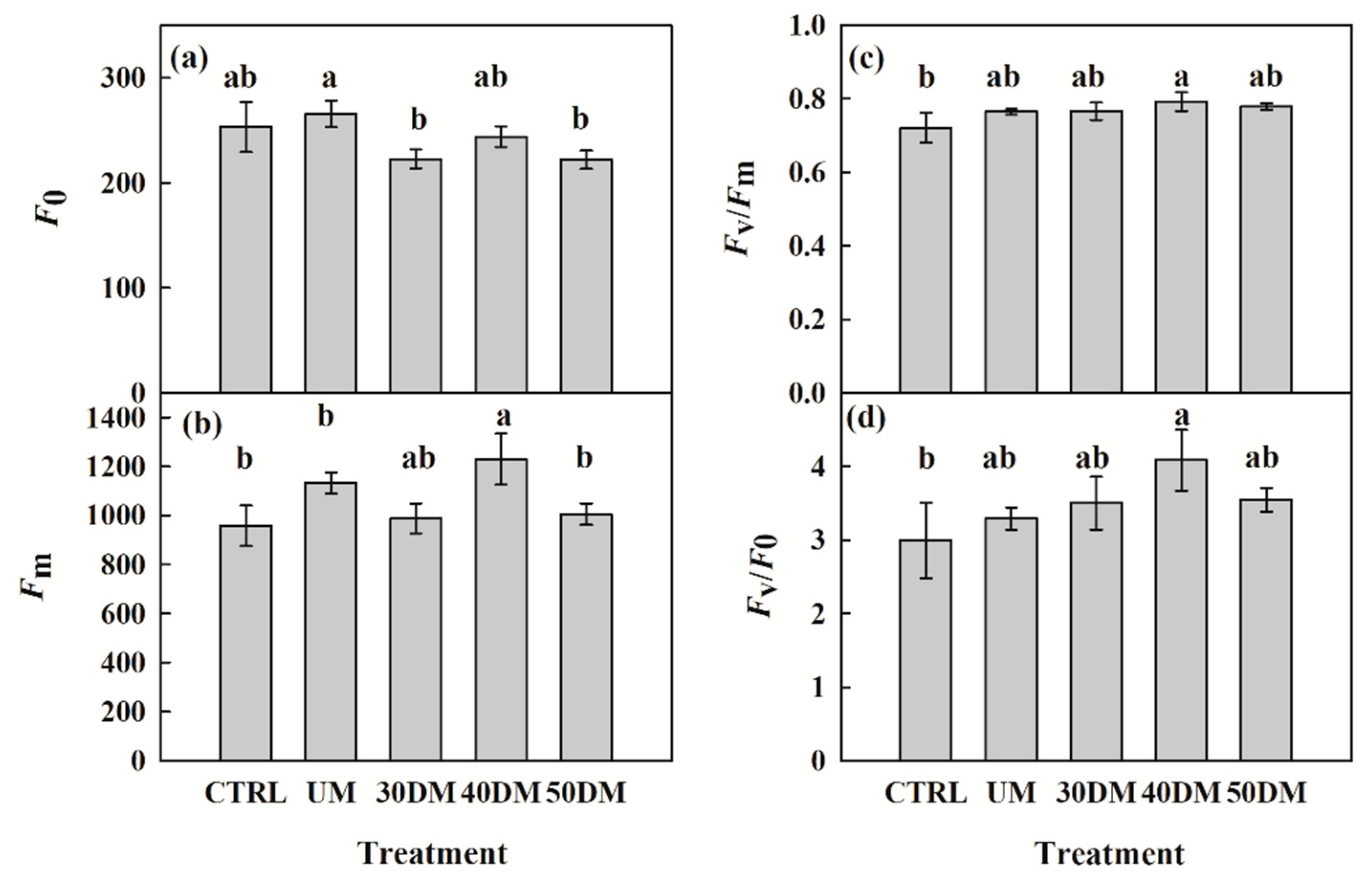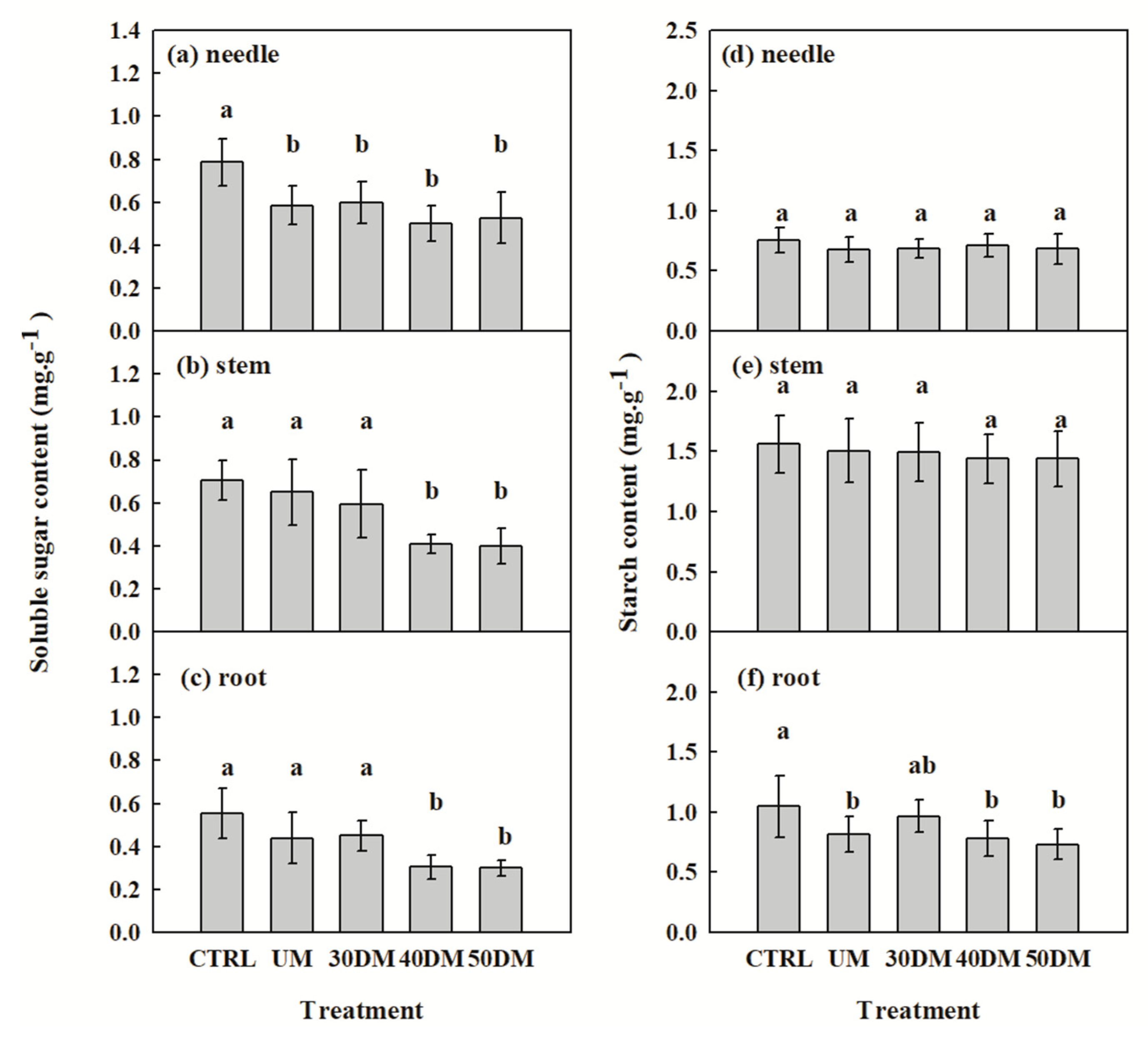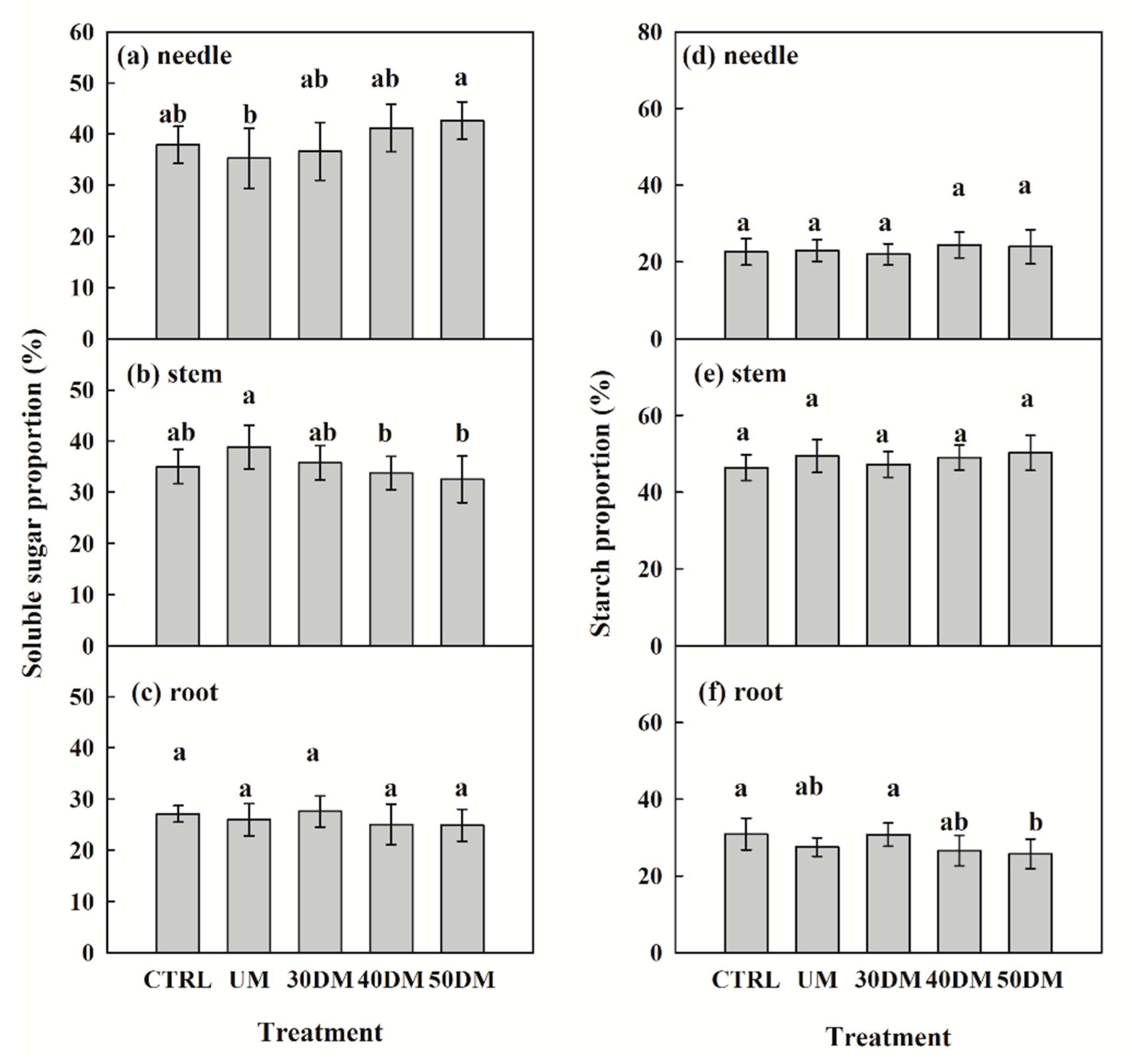Enhanced Root and Stem Growth and Physiological Changes in Pinus bungeana Zucc. Seedlings by Microbial Inoculant Application
Abstract
:1. Introduction
2. Materials and Methods
2.1. Plant Cultivation and Microbial Inoculants Treatments
2.2. Physiological and Growth Measurements
2.2.1. Height and Basal Stem Diameter
2.2.2. Needle, Stem, Root Biomass
2.2.3. Root Morphology
2.2.4. Chlorophyll Content of Needles
2.2.5. Chlorophyll Fluorescence of Needles
2.2.6. Soluble Sugar and Starch Content
2.2.7. Soil Nutrient Content
2.3. Statistical Analysis
3. Results
3.1. Increase in Plant Height and Basal Stem Diameter
3.2. Needle, Stem, and Root Biomass
3.3. Root Morphology
3.4. Chlorophyll Content and Chlorophyll a/b
3.5. Chlorophyll Fluorescence of Needles
3.6. Non-Structural Carbohydrates in Needles, Stems, and Roots
3.7. Soil Nutrient Content
4. Discussion
5. Conclusions
Author Contributions
Funding
Acknowledgments
Conflicts of Interest
References
- Feng, X.P.; Wang, Y.T.; Tang, L.L.; Li, D.W. Polyphenols of leaf, litter and soil of Pinus bungeana across China and their responses to ecological factors. Chem. Biodivers. 2019, 16, e1900205. [Google Scholar] [CrossRef] [PubMed]
- Anev, S. Comparative study on physiological potential of Pinus sylvestris L. and Pinus bungeana Zucc. ex Endl. to grow in Bulgarian urban parks. For. Ideas 2016, 2, 188–197. [Google Scholar]
- Guo, C.C.; Shen, Y.B.; Shi, F.H. Effect of temperature, light, and storage time on the seed germination of Pinus bungeana Zucc. ex Endl.: The role of seed-covering layers and abscisic acid changes. Forests 2020, 11, 300. [Google Scholar] [CrossRef] [Green Version]
- Tian, Q.; Liu, S.W.; Niu, S.H.; Li, W. Development of SNP molecular markers of Pinus bungeana based on SLAF-seq technology. J. Beijing For. Univ. (Chin. Ed.) 2021, 43, 1–8. [Google Scholar]
- Guo, C.C.; Shen, Y.B.; Shi, F.H. Review on seed dormancy of Pinus bungeana Zucc. J. Nanjing For. Univ. (Nat. Sci. Ed.) 2019, 43, 179–187. [Google Scholar]
- Li, H.J. Cultivation of lacebark pine seedlings and its cultivation techniques. J. G Sci. Tech. 2014, 2, 104–105. [Google Scholar]
- Liu, L.N.; Xu, C.Y.; Duan, Y.H.; Zhou, R.Z.; Dai, X.Y. Root morphology of three greening conifer species in Beijing. J. Beijing For. Univ. (Chin. Ed.) 2008, 30, 34–39. [Google Scholar] [CrossRef]
- George, E.; Marschner, H. Nutrient and water uptake by roots of forest trees. Z. Pflanzenernähr. Bodenkd. 1996, 159, 11–21. [Google Scholar] [CrossRef]
- Kour, D.; Rana, K.L.; Yadav, A.N.; Yadav, N.; Kumar, M.; Kumar, V.; Vyas, P.; Dhaliwal, H.S.; Saxena, A.K. Microbial biofertilizers: Bioresources and eco-friendly technologies for agricultural and environmental sustainability. Biocatal. Agric. Biotechnol. 2020, 23, 101487. [Google Scholar] [CrossRef]
- Tang, Y. Study on Promoting Effect of mycorrhizal fungi inoculation on Pinus bungeana Growth. Agric. Sci. Technol. 2013, 14, 1005–1007, 1020. [Google Scholar]
- Liu, Y. Cultivation of Forest Seeds and Seedlings, 1st ed.; China Forestry Press: Beijing, China, 2019; pp. 139–149. [Google Scholar]
- Cripps, C.L.; Grimme, E. Inoculation and successful colonization of whitebark pine seedlings with native mycorrhizal fungi under greenhouse conditions. US Dep. Agric. For. Serv. Rocontraly Mt. Res. Stn. 2011, 63, 312–322. [Google Scholar]
- Verma, J.P.; Yadav, J.; Tiwari, K.N.; Jaiswal, D.K. Evaluation of plant growth promoting activities of microbial strains and their effect on growth and yield of chickpea (Cicer arietinum L.) in India. Soil Biol. Biochem. 2014, 70, 33–37. [Google Scholar] [CrossRef]
- Hui, C.; Sun, P.F.; Guo, X.X.; Jiang, H.; Zhao, Y.H.; Xu, L.G. Shifts in microbial community structure and soil nitrogen mineralization following short-term soil amendment with the ammonifier Bacillus amyloliquefaciens DT. Int. Biodeterior. Biodegrad. 2018, 132, 40–48. [Google Scholar]
- Jamal, Q.; Lee, Y.S.; Jeon, H.D.; Kim, K.Y. Effect of plant growth-promoting bacteria Bacillus amylliquefaciens Y1 on soil properties, pepper seedling growth, rhizosphere bacterial flora and soil enzymes. Plant Prot. Sci. 2018, 54, 129–137. [Google Scholar]
- Ge, X.Y.; He, C.E.; Li, T.; Ouyang, Z. Effect of Bacillus subtilis and Pseudomonas fluorescens on growth of greenhouse tomato and rhizosphere microbial community. J. Northeast Agric. Univ. (Engl. Ed.) 2015, 22, 32–42. [Google Scholar]
- Gasoni, L.; Khan, N.; Yokoyama, K.; Chiessa, G.H.; Kobayashi, K. Impact of Trichoderma harzianum biocontrol agent on functional diversity of soil microbial community in tobacco monoculture in Argentina. World J. Agric. Sci. 2008, 4, 527–532. [Google Scholar]
- Kim, Y.H.; Lim, J.H.; An, C.H.; Jung, B.K.; Kim, S.D. Soil microbial community analysis using soil enzyme activities in red pepper field treated microbial agents. J. Appl. Biol. Chem. 2012, 55, 47–53. [Google Scholar]
- Li, Y.L.; Guo, Q.; Li, Y.Z.; Sun, Y.F.; Xue, Q.H.; Lai, H.X. Streptomyces pactum Act12 controls tomato yellow leaf curl virus disease and alters rhizosphere microbial communities. Biol. Fertil. Soils. 2019, 55, 149–169. [Google Scholar]
- Singh, A.V.; Shah, S.; Prasad, B. Effect of phosphate solubilizing bacteria on plant growth promotion and nodulation in soybean (Glycine max (L.) Merr.). J. Hill Agric. 2010, 1, 35–39. [Google Scholar]
- Singh, U.B.; Malviya, D.; Singh, S.; Pradhan, J.K.; Singh, B.P.; Roy, M.; Imram, K.; Pathak, N.; Baisyal, B.M.; Rai, J.P.; et al. Bio-protective microbial agents from rhizosphere eco-systems trigger plant defense responses provide protection against sheath blight disease in rice (Oryza sativa L.). Microbiol. Res. 2016, 192, 300–312. [Google Scholar] [CrossRef]
- Sui, J.; Ji, C.; Wang, X.; Liu, Z.; Sa, R.; Hu, Y.; Wang, C.; Li, Q.; Liu, X. A plant growth-promoting bacterium alters the microbial community of continuous cropping poplar trees’ rhizosphere. J. Appl. Microbiol. 2019, 126, 1209–1220. [Google Scholar] [CrossRef] [PubMed]
- Li, J.H.; Gao, K.X.; Wan, L.; Cao, G.Y.; Jiao, F.Y.; Wang, Y.P.; Tian, Y.H.; Zhao, B.J.; Li, C.R. Effects of microbial agent on the growth of Catalpa bungei seedlings and the diversity of bacterial community in rhizosphere soil. Acta Ecol. Sinica. 2020, 40, 7588–7601. [Google Scholar]
- Wang, H.; Jia, T.H.; Yang, K.X.; Shi, X.Z.; Gao, T.G.; Zhu, B.C. Antagonistic effect on pathogenic fungi and plant growth promoting mechanism of Bacillus subtilis 8–32. J. Agri. Biotech. 2019, 27, 908–918. [Google Scholar]
- Zhang, X.Z. Determination of chlorophyll content in plants—acetone and ethanol mixture method. Liaoning Agric. Sci. 1986, 3, 26–28. [Google Scholar]
- Hansen, J.; Møller, I. Percolation of starch and soluble carbohydrates from plant tissue for quantitative determination with anthrone. Anal. Biochem. 1975, 68, 87–94. [Google Scholar] [CrossRef]
- Qian, H.; Dong, A.M.; Roitto, M.; Xiang, D.Y.; Zhang, G.; Repo, T.; Wang, A.F. Timing of drought affected the growth, physiology, and mortality of mongolian pine saplings. Forests 2021, 12, 1491. [Google Scholar] [CrossRef]
- Asif, M.; Mughal, A.H.; Lone, S.; Lone, F.A.; Dar, Z.M.; Malik, M.A.; Mir, A.H.; Sheikh, T.A.; Mir, S.A.; Ahanger, F.A.; et al. Influence of different strains of bio-inoculants on relative growth rate of blue pine and Himalayan cypress under temperate nursery conditions. J. Pharmacogn. Phytochem. 2018, 7, 2614–2616. [Google Scholar]
- Brown, M.E.; Carr, G.R. Interaction between Azotobacter chroococcum and vesicular arbuscular mycorrhizae and their effects on plant growth. J. Appl. Bacteriol. 1984, 56, 429–437. [Google Scholar] [CrossRef]
- Cai, N.H.; Tang, J.R.; Li, Y.Q.; Chen, S.; Chen, L.; Xu, Y.; Li, G.Q. Effect of plant growth regulators on root morphology of Pinus yunnanensis seedlings. J. Henan Agric. Univ. 2022, 56, 381–391. [Google Scholar]
- Santos, R.F.D.; Cruz, S.P.D.; Botelho, G.R.; Flores, A.V. Inoculation of Pinus taeda seedlings with plant growth-promoting rhizobacteria. Floresta e Ambiente. 2018, 25, e20160056. [Google Scholar] [CrossRef]
- Kilpeläinen, J.; Domisch, T.; Lehto, T.; Piirainen, S.; Silvennoinen, R.; Repo, T. Separating the effects of air and soil temperature on silver birch. Part I. Does soil temperature or resource competition determine the timing of root growth? Tree Physiol. 2022. [Google Scholar] [CrossRef] [PubMed]
- Bizos, G.; Papatheodorou, E.M.; Chatzistathis, T.; Ntalli, N.; Aschonitis, V.G.; Monokrousos, N. The role of microbial inoculants on plant protection, growth stimulation, and crop productivity of the olive tree (Olea europea L.). Plants 2020, 9, 743. [Google Scholar] [CrossRef]
- Henry, H.A.L.; Aarssen, L.W. Inter-and intraspecific relationships between shade tolerance and shade avoidance in temperate trees. Oikos 2001, 93, 477–487. [Google Scholar] [CrossRef]
- Lukatkin, A.S.; Zauralov, O.A. Exogenous growth regulators as a means of increasing the cold resistance of chilling-sensitive plants. Russ. Agric. Sci. 2009, 35, 384–386. [Google Scholar] [CrossRef]
- Wang, Y.; Wang, J.Y. Effect on cold resistance physiological indexes of manchurian ash seedling leaves under low-temperature stress by ABA. For. Eng. 2010, 26, 32–36. [Google Scholar]
- Hashem, A.; Tabassum, B.; Abd_Allah, E.F. Bacillus subtilis: A plant-growth promoting rhizobacterium that also impacts biotic stress. Saudi J. Biol. Sci. 2019, 26, 1291–1297. [Google Scholar] [CrossRef]
- Woo, O.G.; Kim, H.; Kim, J.S.; Keum, H.L.; Lee, K.C.; Sul, W.J.; Lee, J.H. Bacillus subtilis strain GOT9 confers enhanced tolerance to drought and salt stresses in Arabidopsis thaliana and Brassica campestris. Plant Physiol. Biochem. 2020, 148, 359–367. [Google Scholar] [CrossRef]
- Huang, Q.L.; Yuan, Z.S.; Jiang, T.Y.; Zhu, X.R.; Chen, R.Y.; Zhang, G.F. Effects of different microbial agents on the chlorophyll fluorescence parameters of Cinnamomum camphora. Prot. For. Sci. Technol. 2019, 63, 11–13. [Google Scholar]
- Garcia-Lemos, A.M.; Großkinsky, D.K.; Saleem Akhtar, S.; Nicolaisen, M.H.; Roitsch, T.; Nybroe, O.; Veierskov, B. Identification of root-associated bacteria that influence plant physiology, increase seed germination, or promote growth of the christmas tree species Abies nordmanniana. Front. Microbiol. 2020, 11, 566613. [Google Scholar]
- Zhu, L.X.; Wang, J.H.; Sun, Y.S.; Tang, X.T.; Geng, H. The soluble sugar and starch allocation characteristics after flowering developing in Platycodon grandiflorium. Acta Hortic. Sin. 2010, 37, 319–324. [Google Scholar]
- Song, X.; Peng, C.; Zhou, G.; Gu, H.; Li, Q.; Zhang, C. Dynamic allocation and transfer of non-structural carbohydrates, a possible mechanism for the explosive growth of Moso bamboo (Phyllostachys heterocycla). Sci. Rep. 2016, 6, 1–8. [Google Scholar] [CrossRef] [PubMed] [Green Version]
- Smith, M.G.; Miller, R.E.; Arndt, S.K.; Kasel, S.; Bennett, L.T. Whole-tree distribution and temporal variation of non-structural carbohydrates in broadleaf evergreen trees. Tree Physiol. 2018, 38, 570–581. [Google Scholar] [CrossRef] [PubMed]
- Yang, X.; Peng, J.; Zhang, M.M.; Zhang, Q.; Liu, X. Effects of foliar spraying of 6-BA on carbohydrate transfer and allocation of maize at the reproductive stage. J. Northwest Sci.-Tech. Univ. Agric. For. (Nat. Sci. Ed.) 2019, 47, 62–70. [Google Scholar]
- Hu, X.Q.; Sun, L.; Luo, S.G.; Liu, Y.Y. Effect of integrated nutrient management on accumulation and distribution of sugar and yield of soybean. J. Northeast Agric. Univ. (Chin. Ed.) 2011, 42, 8–12. [Google Scholar]
- Kong, J.; He, Z.; Chen, L.; Yang, R.; Du, J. Efficiency of biochar, nitrogen addition, and microbial agent amendments in remediation of soil properties and microbial community in Qilian Mountains mine soils. Ecol. Evol. 2021, 11, 9318–9331. [Google Scholar] [PubMed]
- Mengual, C.; Roldán, A.; Caravaca, F.; Schoebitz, M. Advantages of inoculation with immobilized rhizobacteria versus amendment with olive-mill waste in the afforestation of a semiarid area with Pinus halepensis Mill. Ecol. Eng. 2014, 73, 1–8. [Google Scholar]
- Yang, K.X.; Wang, H.; Liu, X.J.; Shi, X.Z.; Jia, T.H.; Gao, T.G. Effect of Bacillus Subtilis 8–32 on soil enzymes and microflora of potted soybean. Soybean Sci. 2018, 37, 762–768. [Google Scholar]
- Tejada, M.; Hernandez, M.T.; Garcia, C. Soil restoration using composted plant residues: Effects on soil properties. Soil Tillage Res. 2009, 102, 109–117. [Google Scholar] [CrossRef]
- Luo, L.; Zhao, C.; Wang, E.; Raza, A.; Yin, C. Bacillus amyloliquefaciens as an excellent agent for biofertilizer and biocontrol in agriculture: An overview for its mechanisms. Microbiol. Res. 2022, 259, 127016. [Google Scholar] [CrossRef]
- Vassilev, N.; Vassileva, M.; Nikolaeva, I. Simultaneous P-solubilizing and biocontrol activity of microorganisms: Potentials and future trends. Appl. Microbiol. Biotechnol. 2006, 71, 137–144. [Google Scholar]







| Treatment | Plant Height Increase (cm) | Stem Diameter Increase (mm) |
|---|---|---|
| CTRL | 0.50 ± 0.07 c | 0.12 ± 0.06 c |
| UM | 2.15 ± 0.23 b | 0.45 ± 0.06 ab |
| 30 DM | 1.17 ± 0.18 b | 0.46 ± 0.01 a |
| 40 DM | 0.45 ± 0.06 c | 0.53 ± 0.03 a |
| 50 DM | 3.70 ± 0.37 a | 0.36 ± 0.01 b |
Publisher’s Note: MDPI stays neutral with regard to jurisdictional claims in published maps and institutional affiliations. |
© 2022 by the authors. Licensee MDPI, Basel, Switzerland. This article is an open access article distributed under the terms and conditions of the Creative Commons Attribution (CC BY) license (https://creativecommons.org/licenses/by/4.0/).
Share and Cite
Liu, Y.-M.; Zheng, F.; Liu, Z.-H.; Lan, H.-B.; Cui, Y.-H.; Gao, T.-G.; Roitto, M.; Wang, A.-F. Enhanced Root and Stem Growth and Physiological Changes in Pinus bungeana Zucc. Seedlings by Microbial Inoculant Application. Forests 2022, 13, 1836. https://doi.org/10.3390/f13111836
Liu Y-M, Zheng F, Liu Z-H, Lan H-B, Cui Y-H, Gao T-G, Roitto M, Wang A-F. Enhanced Root and Stem Growth and Physiological Changes in Pinus bungeana Zucc. Seedlings by Microbial Inoculant Application. Forests. 2022; 13(11):1836. https://doi.org/10.3390/f13111836
Chicago/Turabian StyleLiu, Yi-Ming, Fang Zheng, Zhao-Hui Liu, Hai-Bo Lan, Ye-Hong Cui, Tong-Guo Gao, Marja Roitto, and Ai-Fang Wang. 2022. "Enhanced Root and Stem Growth and Physiological Changes in Pinus bungeana Zucc. Seedlings by Microbial Inoculant Application" Forests 13, no. 11: 1836. https://doi.org/10.3390/f13111836





